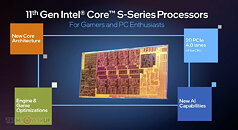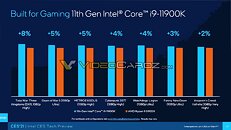Monday, January 11th 2021

Intel 11th Gen Core "Rocket Lake-S" Processor Detailed Some More
Intel at a January 11, 2021 online media event (which we live-blogged here) revealed more information about its 11th Generation Core "Rocket Lake-S" desktop processor family. These chips succeed the 10th Gen Core "Comet Lake-S," and are built on the same Socket LGA1200 package, retaining backwards compatibility with Intel 400-series chipset motherboards with firmware updates; and native support with the upcoming Intel 500-series chipset motherboards. Intel in its media event confirmed that the top Core i9-11900K is an 8-core/16-thread processor, which will deliver the highest PC gaming performance possible when it comes out.
In its media event, Intel revealed a side-by-side comparison of the i9-11900K with a machine powered by the AMD Ryzen 9 5900X 12-core processor, where it's shown offering a mostly mid-single-digit-percentage performance lead over the AMD chip. In the "Metro Exodus" benchmark prominently highlighted in the Intel event, the i9-11900K is shown offering an average frame-rate of 156.54 FPS compared to 147.43 FPS of the 5900X (a 6.17% gain). VideoCardz tweeted a leaked Intel presentation slide with many more game test results where Intel compared the two chips. Intel's play with marketing "Rocket Lake-S" to gamers and PC enthusiasts will hence ride on the back of gaming performance leadership, and future-proofing against the new wave of productivity apps that leverage AI deep-learning, as "Rocket Lake-S" features DLBoost VNNI extensions that accelerate deep-learning neural-net building, training, and AI inference performance.Intel's presentation also revealed the first die-shot of the "Rocket Lake-S" silicon, which reveals that it physically only features 8 CPU cores. The die appears visibly wide than that of an 8-core or 10-core "Comet Lake" or "Coffee Lake Refresh" dies; and slightly longer than the 8-core "Coffee Lake Refresh," which probably explains why Intel capped out at 8 cores with the LGA1200 package. The "Cypress Cove" CPU cores are visibly larger than "Skylake", bearing in mind that the "Rocket Lake-S" is built on existing 14 nm process, so it's possible to compare core sizes given the identical transistor densities. The cores feature larger caches, given that Intel has enlarged the dedicated L2 cache per core to 512 KB, up from 256 KB on "Skylake." The shared L3 cache is still 16 MB.It's also worth noting that the uncore area of the die, which features its memory controllers and main PCIe switching fabric, is noticeably larger than that of "Skylake" thru "Comet Lake" dies. This is due to the switch to PCI-Express Gen 4.0, and the processor putting out 28 PCIe lanes as opposed to just 20 on the "Comet Lake-S." That's 16 lanes toward PEG, 4 toward a CPU-attached NVMe slot, and 8 toward the DMI chipset bus (compared to just 4 on the older platforms). The memory controllers could be largely unchanged since the platform features the same dual-channel DDR4 memory interface. Elsewhere across the die, we see the new Gen12 Xe-LP iGPU, which unless we're mistaken, is slightly smaller in area than the Gen9.5 iGPUs. This variant of the Iris Xe iGPU is much smaller (in functionality, not die-area) than the one you'd find in 11th Gen Core "Tiger Lake" mobile processors, as it features half the number of execution units (48, compared to 96 on the "Tiger Lake").In its call, Intel still hasn't revealed availability of the 11th Gen Core "Rocket Lake-S," although several PC motherboard makers have gone on record to mention a "late March 2021" release.
In its media event, Intel revealed a side-by-side comparison of the i9-11900K with a machine powered by the AMD Ryzen 9 5900X 12-core processor, where it's shown offering a mostly mid-single-digit-percentage performance lead over the AMD chip. In the "Metro Exodus" benchmark prominently highlighted in the Intel event, the i9-11900K is shown offering an average frame-rate of 156.54 FPS compared to 147.43 FPS of the 5900X (a 6.17% gain). VideoCardz tweeted a leaked Intel presentation slide with many more game test results where Intel compared the two chips. Intel's play with marketing "Rocket Lake-S" to gamers and PC enthusiasts will hence ride on the back of gaming performance leadership, and future-proofing against the new wave of productivity apps that leverage AI deep-learning, as "Rocket Lake-S" features DLBoost VNNI extensions that accelerate deep-learning neural-net building, training, and AI inference performance.Intel's presentation also revealed the first die-shot of the "Rocket Lake-S" silicon, which reveals that it physically only features 8 CPU cores. The die appears visibly wide than that of an 8-core or 10-core "Comet Lake" or "Coffee Lake Refresh" dies; and slightly longer than the 8-core "Coffee Lake Refresh," which probably explains why Intel capped out at 8 cores with the LGA1200 package. The "Cypress Cove" CPU cores are visibly larger than "Skylake", bearing in mind that the "Rocket Lake-S" is built on existing 14 nm process, so it's possible to compare core sizes given the identical transistor densities. The cores feature larger caches, given that Intel has enlarged the dedicated L2 cache per core to 512 KB, up from 256 KB on "Skylake." The shared L3 cache is still 16 MB.It's also worth noting that the uncore area of the die, which features its memory controllers and main PCIe switching fabric, is noticeably larger than that of "Skylake" thru "Comet Lake" dies. This is due to the switch to PCI-Express Gen 4.0, and the processor putting out 28 PCIe lanes as opposed to just 20 on the "Comet Lake-S." That's 16 lanes toward PEG, 4 toward a CPU-attached NVMe slot, and 8 toward the DMI chipset bus (compared to just 4 on the older platforms). The memory controllers could be largely unchanged since the platform features the same dual-channel DDR4 memory interface. Elsewhere across the die, we see the new Gen12 Xe-LP iGPU, which unless we're mistaken, is slightly smaller in area than the Gen9.5 iGPUs. This variant of the Iris Xe iGPU is much smaller (in functionality, not die-area) than the one you'd find in 11th Gen Core "Tiger Lake" mobile processors, as it features half the number of execution units (48, compared to 96 on the "Tiger Lake").In its call, Intel still hasn't revealed availability of the 11th Gen Core "Rocket Lake-S," although several PC motherboard makers have gone on record to mention a "late March 2021" release.




18 Comments on Intel 11th Gen Core "Rocket Lake-S" Processor Detailed Some More
If Intel would ditch that useless die space taken up by their unnecessary iGPUs, maybe they could have more than 8 cores again. Even if those numbers are perfectly accurate, given what we know about how poorly multi threaded games currently are, who is going to give up 4 cores for 2-8% at 1080P, when at 4K those numbers will be much tighter and you'll also have 4 fewer cores for your entire system.
Ive build a few rigs for people in the last year where they really dont need a GPU that will do much more than let them run multiple monitors and so I went with Intel 6 and 8 core CPUs.
Edit: I will admit, to Intel's credit, that I don't run a massive multi billion dollar company so their engineers probably know something I don't, but let's not overlook the fact that the only reason these are 8 core parts and not 12+ is that iGPU, which will be completely useless to a lot of readers here. And I can't remember the last time I saw a PC with a high end desktop CPU at Costco etc that didn't also have a Radeon or Geforce card.
If this is Intel's wording, it makes me question the gains over both amd and previous Intel chips. Specifically the word" possible" instead of something like "ever" or "to date".
But I could also e reading too much into it. Time will tell.
I would hope Intel would undercut that price point given the lower multi-core ability of 11900K vs 5900X. 8 cores is fine for gaming and the vast majority of users, but if a 12 core is at the same price with similar single thread performance and better multi-thread, it would be kind of a no-brainer to go for the 5900X.
OFC, if RKL is actually available, that's going to be a big win.